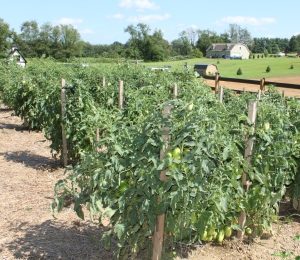It will be time to be planting vegetables before you know it!
Planting day is one of the most critical moments for the success of your garden – because getting your new vegetable transplants off to a good start is a vital key to having bountiful harvests through the summer and early fall months.
Here are some helpful tips to help you on planting day:
4 Tips To Planting Vegetables:
1. Create a great planting hole
No matter if you have hard clay, or rich soil full of organic matter – you can make a big difference in the health and long-term success of your vegetable plants by taking time to create a great environment for your plant’s new home. After all – it is the soil right around the roots of your plant that will be of the most importance to your plants!
We use a post hole digger to dig down and easily remove 6 to 8 inches of soil where the new transplant will go. We then add a few cups of good compost to each hole along with the plant. As an extra plant booster – we also mix in a few crushed eggs shells and a couple of teaspoons of coffee grounds in to each planting hole soil.
Why? Crushed egg shells are an excellent supplement adding calcium to the soil as they break down (helping to prevent the all-too common blossom rot in tomatoes), And coffee grounds are high in Nitrogen – and when mixed into the soil can give a little boost to the plants as well. See: Planting With A Post Hole Digger
2. Mulch your plants
We mulch all of our vegetable plants with about a 2″ thick layer of compost – creating a 6 to 8″ compost circle around each stalk.
Not only does it help to keep weeds to a minimum, and the soil from eroding during strong rains – it also helps to regulate the temperature of the soil – keeping it warmer on cool nights – and cooler on hot days.
Even better – compost mulch acts as a slow-release fertilizer as nutrients strain through it during watering or rainfalls.
One caution when mulching in the late spring. If the season and soil are still a little cool – wait a few weeks for it to warm up before applying the mulch. If the soil is still cool, mulching can actually prolong the soil from heating up. See: Mulching In The Garden
3. Stay off of the soil around your plants!
One of the biggest hindrances to a plant reaching maximum growth and yields are compacted roots.
When roots are compacted, they have a harder time soaking up the water and nutrients that are so vital to their growth. They also have a difficult time expanding and growing a larger root structure – which hinders the top growth and yields as well.
Make sure as you work in your garden to stay off the ground directly around your plants – stepping on and around your plant’s root zone compacts the soil and keeps them from fully developing. It is one of the reasons I love our raised rows so much – it naturally protects root zones.
4. Water smart
It is vital to water your plants liberally on planting day to help them tolerate the stress of the transplant. We put about a cup of water into the hole and then water the plant again once it is in the ground. If we plant in the early morning – we will check at the end of the day to see if there are any signs of wilt and maybe give it another drink in the evening if needed.
When plants are very young and for the first week or so after transplanting into the garden, you may need to water daily to get them established.
After that – watering every day is a no-no. Most vegetable plants need about 1 inch of water a week. If mother nature can’t supply that – then you need to supplement. If you are experiencing a prolonged dry spell – water every two to three days with about a 1/2″ of water to the plant at a time. This allows enough water to go deep into the soil and create longer roots. Don’t fall into the “water every day habit” though for established plants. Plants that get a little water every day never send their roots deeper to look for moisture and nutrients – and you end up with a weak root system and a weak plant. See: Ins and Outs of Watering Your Garden
So there you have it – some helpful hints when planting vegetables that should help get your garden off to a great start this year!
If you are looking for more information on planting seeds, then you need to check out our article: How To Create A Tabletop Seed Starting Stand With Ease – And Grow Your Own Plants This Year!
If you would like to receive our DIY & Gardening Tips each week – be sure to sign up to follow the blog via email in the right hand column, “like” us on Facebook, or follow us on Twitter.
Happy Gardening – Jim and Mary!





